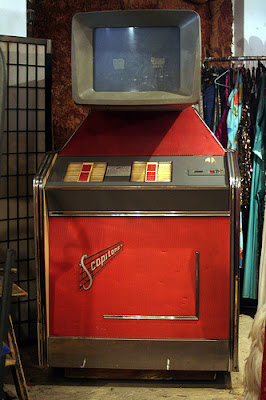As a class we visited 'Rich Mix' in London. Pete Fraser shared a presentation on the history of the music video as well as codes and conventions and top tips for making our own pop promo. This was then followed by a more active session with Liz Kessler who works in the industry commissioning and producing music videos, who was later joined by Corin Hardy (director), who shared some of his work. For example, The Prodigy, 'Warriors dance' and The Horrors 'She is the new thing'.
Music videos feature an artist but not always. They often last the length of the song however again, not always. They must be visually memorable and the music should be illustrated by visuals whether this is through metaphors or obvious images.
Len Lye was the first to create a visual that was later referred to as a music video which purely described a visual accompanied by music. 'A colour box', although now seems extremely dated and poor quality, was used as an advertisement for the postal system in 1935. Unlike more modern times whereby videos are created mainly via relevant programmes on computers, A colour box was created by painting directly onto film which produced bright colours when projected.
Music videos feature an artist but not always. They often last the length of the song however again, not always. They must be visually memorable and the music should be illustrated by visuals whether this is through metaphors or obvious images.
Len Lye was the first to create a visual that was later referred to as a music video which purely described a visual accompanied by music. 'A colour box', although now seems extremely dated and poor quality, was used as an advertisement for the postal system in 1935. Unlike more modern times whereby videos are created mainly via relevant programmes on computers, A colour box was created by painting directly onto film which produced bright colours when projected.
Soundies came about in the 1940's these are video duke boxes. 4000 were installed in the USA alone. They are used as promotions for songs being released. For example, 'From Fram Sauce' by Nat King Cole, which was a performance based video including voyeurism, became famous through the exploitation of it on soundies.
As a development of soundies, scopitones originated in France in the 1960's which were colour, low budget video players which primarily showed music videos that consisted of a large amount of dancing.
Also in the 1960's, the Beatles became particularly popular from their song 'A hard day's night' because it was shown in a film starring them in the form of a music video. It worked as a showcase for films on an album, 'Can't buy me love', as a substitute for touring due to other commitments, and constraints. These showcase films became a useful method of advertisement.
Queen famously remembered from the 1970's due to their music video for 'Bohemian Rhapsody'. It cost £3000 in total to make which was a substantial amount of money at the time.
MTV the music channel was first premièred in 1981. This was the first channel purely for music videos. The music videos shown were specifically dominated by males. The first video to be shown on MTV was 'Video killed the radio star'.
The USA then got involved firstly promoting Madonna's music video's for example, 'Open your heart'. The budget for music video making drastically increased from that in the UK.
Michael Jackson was the breakthrough for Black acts with him music video 'Thriller' which shocked viewers because of its gore and form being a short film. It cost millions of dollars to make. Before this, black music was rarely shown because producers believed there was no market for black people.
Artists such as 50 Cent started creating songs and music videos that were particularly explicit and whereby the lyrics matched the visuals. This triggered the start of having separate music channels for different genres. 'Candy shop' is specifically remembered for its use of excess materialistic, luxurious and desirable items including bling, models, expensive cars and a mansion. These were all used to portray sexuality.
Jay Z's '99 problems' video consists of 400 cuts in 4 minutes. The main themes shown are violence and sex although it appears controversial and political.
As equipment improved and became more affordable, regular people began to create home made videos, sometimes remakes of videos on their phones and ipods. This along with the ability to download music from the internet for free, is a massive threat to the music industry.








No comments:
Post a Comment